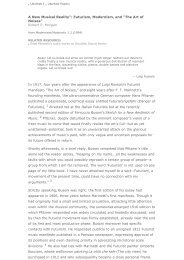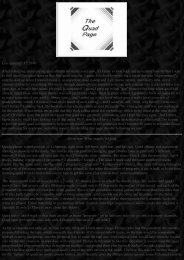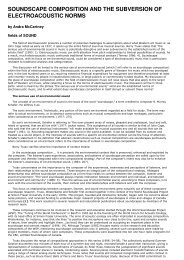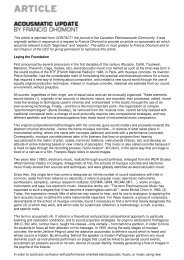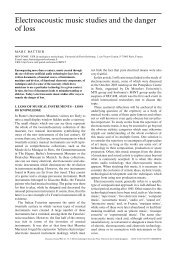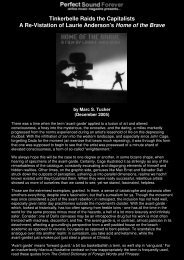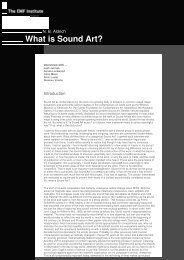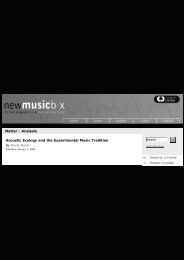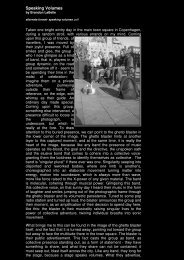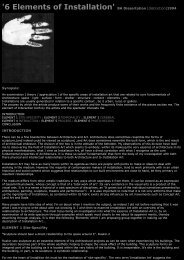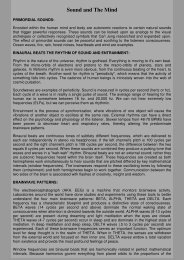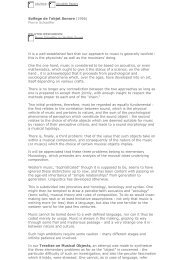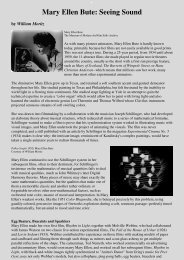'Sound art, radio art,and post-radio performance in Australia ...
'Sound art, radio art,and post-radio performance in Australia ...
'Sound art, radio art,and post-radio performance in Australia ...
Create successful ePaper yourself
Turn your PDF publications into a flip-book with our unique Google optimized e-Paper software.
poem to accompany her. So the higher she speaks, the later is the l<strong>in</strong>e which accompanies her. If she speaks<br />
very high, then l<strong>in</strong>e sixteen is played by the mach<strong>in</strong>e. If she speaks very low, l<strong>in</strong>e one is played ... You could<br />
hear many more than two l<strong>in</strong>es simultaneously. Once a l<strong>in</strong>e's triggered off it will play for quite a while ... So<br />
you could get a number of voices happen<strong>in</strong>g - a number of Am<strong>and</strong>a voices.<br />
While he acknowledged that these voices might appear confus<strong>in</strong>g Burt argues that It Becomes is well suited to such<br />
sonic amplification:<br />
Because we know the text we can follow it through, <strong>and</strong> hear very clearly what is live voice <strong>and</strong> what is<br />
accompaniment. Other people would have difficulty do<strong>in</strong>g that, <strong>and</strong> that's f<strong>in</strong>e, because of the nature of the<br />
poem. It Becomes is so chancy <strong>and</strong> <strong>in</strong>cantatory that hav<strong>in</strong>g other l<strong>in</strong>es from other p<strong>art</strong>s of the poem actually<br />
makes structural sense.<br />
Confirm<strong>in</strong>g Burt's conclusion, Am<strong>and</strong>a Stew<strong>art</strong> writes:<br />
This solo voice poem is so tautological <strong>and</strong> self-consum<strong>in</strong>g <strong>in</strong> its structure that it was quite appropriate to<br />
have IT accompany ITself <strong>in</strong> this way. In the orig<strong>in</strong>al live <strong>performance</strong> there's a certa<strong>in</strong> hysteria flex<strong>in</strong>g<br />
<strong>in</strong>side its military rhythm. Our collaboration gives its ridiculous <strong>in</strong>cantations more emphasis <strong>and</strong> dimension.<br />
But more importantly, br<strong>in</strong>g<strong>in</strong>g the solo voice poem to <strong>radio</strong> <strong>in</strong> this way not only extended its orig<strong>in</strong>al<br />
structure, but also opened the piece to new conceptual areas, mak<strong>in</strong>g it a new <strong>radio</strong>phonic entity.<br />
Other sections of Collaboration <strong>in</strong>clude two improvisations: Improv I <strong>and</strong> Improv 2. Once aga<strong>in</strong>, Burt extended live<br />
<strong>performance</strong> by record<strong>in</strong>g <strong>and</strong> recycl<strong>in</strong>g fragments of earlier read<strong>in</strong>gs. Recall<strong>in</strong>g that he first asked Am<strong>and</strong>a Stew<strong>art</strong> to<br />
'improvise funny non-verbal vocal sounds', Burt cont<strong>in</strong>ues:<br />
While she did that, I had the microphone go<strong>in</strong>g all the time, <strong>and</strong> whenever I heard a sound I liked, I sampled<br />
it <strong>in</strong>to the sampler, <strong>and</strong> ended up with seventeen little short vocal sounds ... I then arranged the keyboard of<br />
the sampler <strong>in</strong> such a way that each three chromatic pitches had a different Am<strong>and</strong>a sound on it. Over the<br />
course of a four octave keyboard I had seventeen sounds available. So that C, C sharp <strong>and</strong> D might be such<br />
<strong>and</strong> such a sound at three different pitches, <strong>and</strong> so on. And then I said, 'Why don't I improvise on this<br />
keyboard while you improvise aga<strong>in</strong>st it'?<br />
In her turn, Am<strong>and</strong>a Stew<strong>art</strong> enthusiastically relates:<br />
I was really excited about this p<strong>art</strong> of our collaboration. I've always used extended vocal techniques <strong>in</strong> my<br />
poems, but usually <strong>in</strong> relation to how words mean <strong>and</strong> break ap<strong>art</strong>. This p<strong>art</strong>icular <strong>radio</strong>phonic technique<br />
enabled a fast, immediate exchange of a number of different vocal sounds <strong>in</strong> improvisation, allow<strong>in</strong>g us to<br />
explore a huge range of <strong>in</strong>terrelationships, often simultaneously. The vocal sounds might be heard as<br />
phonemes or half words, expressionist grunts or musical materials. But what's important is that oppositions<br />
like those between language/ music, mach<strong>in</strong>e/human, subject/object, break down, mak<strong>in</strong>g other<br />
underst<strong>and</strong><strong>in</strong>gs more imperative. I'm still underst<strong>and</strong><strong>in</strong>g the implications of us<strong>in</strong>g this type of <strong>radio</strong>phonic<br />
vocabulary.<br />
Not all responses to these collaborations were favourable. Burt notes:<br />
A lot of Am<strong>and</strong>a's fem<strong>in</strong>ist/politico friends were unhappy with the piece - not only because she dared to<br />
work with a male, <strong>and</strong> dared to use technology, but ma<strong>in</strong>ly because there was music <strong>in</strong> it that they couldn't<br />
f<strong>in</strong>d politically useable.<br />
While these responses typify the highly politicized perspective of many <strong>Australia</strong>n poets, Burt's own reactions to the<br />
collaboration have much more <strong>in</strong> common with the more formal explorations of the <strong>in</strong>terface between speech <strong>and</strong> music<br />
<strong>in</strong> the work of American composers such as Laurie Anderson, Steve Reich, Alv<strong>in</strong> Lucier <strong>and</strong> Robert Ashley. Consider<strong>in</strong>g<br />
Collaboration aesthetically, Burt drew attention to the ways <strong>in</strong> which its successive sections add various k<strong>in</strong>ds of 'corona<br />
of sound' to live declamation, <strong>and</strong> create an overlap between real time <strong>and</strong> pre-recorded <strong>performance</strong>. For example,<br />
referr<strong>in</strong>g to the tw<strong>in</strong> tracks of the improvisation, he comments<br />
There are moments when its obvious that one is a mach<strong>in</strong>e th<strong>in</strong>g be<strong>in</strong>g played, <strong>and</strong> the other is a live human<br />
be<strong>in</strong>g. But there are other moments when it blurs ... Those moments are actually very nice.<br />
As Burt also very significantly remarks, the most important consequence of these collaborations are their general<br />
conceptual challenges, rather than m<strong>in</strong>or generic dist<strong>in</strong>ctions between music <strong>and</strong> poetry, or between live <strong>and</strong>



